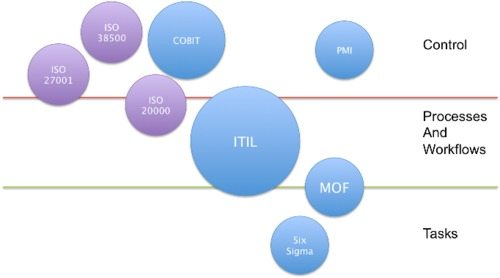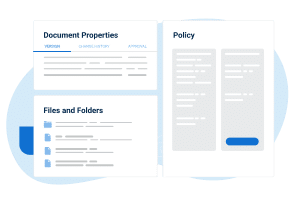First, let’s establish a clear difference between the terms “ITSM standard” and “ITSM framework”. Standards are sets of clearly defined and measurable rules and requirements that have to be met in order to consider something compliant with the standard in question. Frameworks, or best practices, offer only guideline on the subject in hand: “what to do,” without “how to do it,” with the possibility to implement them partially, selectively or not at all. Today there are many IT Service Management frameworks and standards, with the most notable being ITIL. Therefore, in this article, we’ll explore ITIL and complementary frameworks and standards (you can learn more in this blog post: ITIL and ISO 20000: A Comparison).

In this figure you can gain some perspective as to how different frameworks and practices fit into areas of organizational control, processes, or individual tasks of IT Service Management. Their relative importance / impact to IT Service Management in general is represented by size. Please note that this figure is a simplified impression of very complex topics.
ITIL
Today, ITIL is the most recognizable IT Service Management practice (often described as best practice), with an accompanying framework that is clear and easy to follow and implement. ITIL best practice describes processes involved in the Service Lifecycle, with a focus on efficiency and effectiveness. This kind of approach makes ITIL the center of IT Service Management, and other frameworks and standards can be considered as complements to ITIL within ITSM.
ISO 20000
ISO 20000 is the standard originally developed to reflect best practices within ITIL. However, while ITIL lists only recommendations, ISO 20000 states clear specifications for a Service Management System, focused around the alignment between service delivery and requirements, efficiency and control of services. ISO 20000 complements ITIL well, and ITIL adopters can fulfill ISO 20000 requirements with relative ease. You can read more about ISO 20000 and ITIL – How are they related?
Six Sigma
Six Sigma is a framework that is designed for process improvement by identifying and removing the causes of defects or errors. The Six Sigma methodology is particularly compatible with ITIL; a basic premise of Six Sigma is a focus on improvement efforts surrounding process, product or service performance that impacts the end user. This relationship is very similar to the relationship of services to the business and how those services are managed via the ITIL processes. Even though it’s not directly addressed to IT, Six Sigma methodology includes process reengineering, metrics, roles and responsibilities, while addressing change management, and is mostly operational procedure based.
ISO 27001
Part of IT Service Management is addressing security concerns in information management systems. The ISO 27000 series, and ISO 27001 in particular, is a standard that states requirements for “Information technology – Security techniques – Information security management systems.” In terms of IT Service Management, it’s very important that services are designed and operated in a manner that ensures protection of information assets from a wide range of threats that may interrupt business continuity, and minimize business damage. In short, the ISO 27001 implementation ensures the preservation of Confidentiality, Integrity and Availability of business-critical data.
To implement ISO 20000 easily and efficiently, use our ISO 20000 Documentation Toolkit that provides step-by-step guidance for full ISO 20000 compliance.

 Neven Zitek
Neven Zitek 


